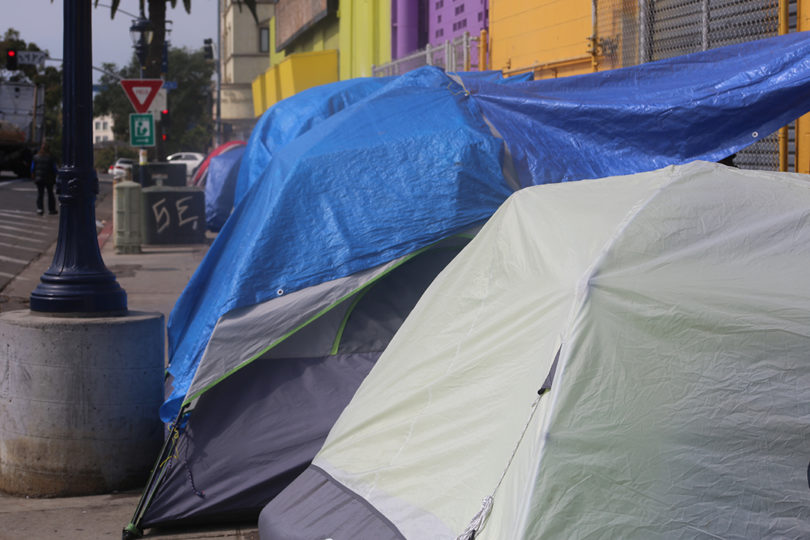
By SDCN
Washington, D.C.–The U.S. Department of Housing and Urban Development (HUD) Monday released its 2022 Annual Homeless Assessment Report Part 1 to Congress.
The report found that there were 582,462 people experiencing homelessness on a single night in January 2022. COVID-19 and its impacts on the economy could have led to significant increases in homelessness, however, investments, partnerships, and outreach by government agencies lead to only a .3 % increase in the number of people experiencing homelessness from 2020 to 2022. Compared with 2020, homelessness among people in shelters declined by 1.6%, while homelessness among people in unsheltered settings increased by 3.4%. The overall rate of homelessness decreased due in large part to a robust federal response that prevented evictions through Emergency Rental Assistance distributed to more than three million households, expanded resources for vulnerable families through the Child Tax Credit, and provided other financial transfers through stimulus.
Homelessness among certain sub-populations decreased. The report found that the number of veterans experiencing homelessness decreased by 11 percent, a 55 percent decrease since 2010. Between 2020 and 2022, the number of families with children experiencing homelessness declined by six percent between 2020 and 2022, marking a total decline of 36 percent since 2010. There was a 12 percent decrease in the number of people under the age of 25 who experienced homelessness on their own as “unaccompanied youth.”
“HUD and everyone in the Biden-Harris Administration is committed to ensuring everyone has a safe, stable place to call home. Data shows that homelessness remains a national crisis, but it also shows that the historic investments this Administration has made to address this issue, can work,” said Department of Housing and Urban Development (HUD) Secretary Marcia Fudge. “The Biden-Harris Administration is committed to systemically addressing homelessness and combating the systemic racism that has created racial and ethnic disparities in homelessness.”
While the overall number of people experiencing homelessness in 2022 increased slightly compared with 2020, it rose significantly for individuals, people with disabilities who experience long-term homelessness, and people in unsheltered settings. Single individuals that are not part of family households continue to represent the largest group of people experiencing homelessness. Homelessness among single individuals increased by 3.1%. The number of chronically homeless individuals (individuals with disabilities who have been homeless for long periods of time) increased by 16 percent between 2020 and 2022.
“Under the leadership of Secretary Fudge, HUD recognizes housing’s role as essential to all people and is working with our federal, state, local and tribal partners to reserve decades of underinvestment in housing and services,” said Regional Administrator Jason Pu who leads HUD’s Region IX operations in Arizona, California, Hawaii, Nevada, and the Outer Pacific Islands.
There continues to be an overrepresentation of people who identify as Black, African American, or African, as well as indigenous people (including Native Americans and Pacific Islanders) among people experiencing homelessness.
These data reflect a single-night snapshot of homelessness in America in early 2022 and the first complete single-night count of people experiencing homelessness since the arrival of the COVID-19 pandemic. The data shows that overall homelessness remained relatively unchanged despite the economic challenges created by the COVID-19 pandemic. This may be due in large part to federal actions that provided communities with additional homeless assistance resources and regulatory flexibilities, prevented renters from evictions through emergency rental assistance, expanded resources for vulnerable families through the Child Tax Credit, and provided other financial transfers through stimulus. These results, however, do not reflect the full impact of the Biden-Harris Administration’s American Rescue Plan and HUD’s House America initiative, which largely took place during the calendar year 2022. For instance, the majority of HUD’s Emergency Housing Voucher program lease-ups took place during 2022. Also, in 2022, HUD released a first-of-its-kind Initiative to Address Unsheltered and Rural Homelessness, which HUD plans to award early in 2023.
HUD releases the Annual Homeless Assessment Report to Congress in two parts. Part 1 provides Point-in-Time estimates, offering a snapshot of homelessness on a single night. The one-night counts are conducted during the last 10 days of January each year, with extensions approved on a case-by-case basis. The PIT counts also provide an estimate of the number of people experiencing homelessness within particular homeless populations such as individuals with chronic patterns of homelessness and veterans experiencing homelessness.
The 2022 report provides comparisons with 2020 data because many communities were considerably impacted by COVID-19 during the 2021 Point in Time count and did not conduct an unsheltered count. The 2020 Point in Time estimate included both sheltered and unsheltered homelessness. In addition, the report compares 2022 data to data from 2010, the first year that the federal government set a national goal to end homelessness.





